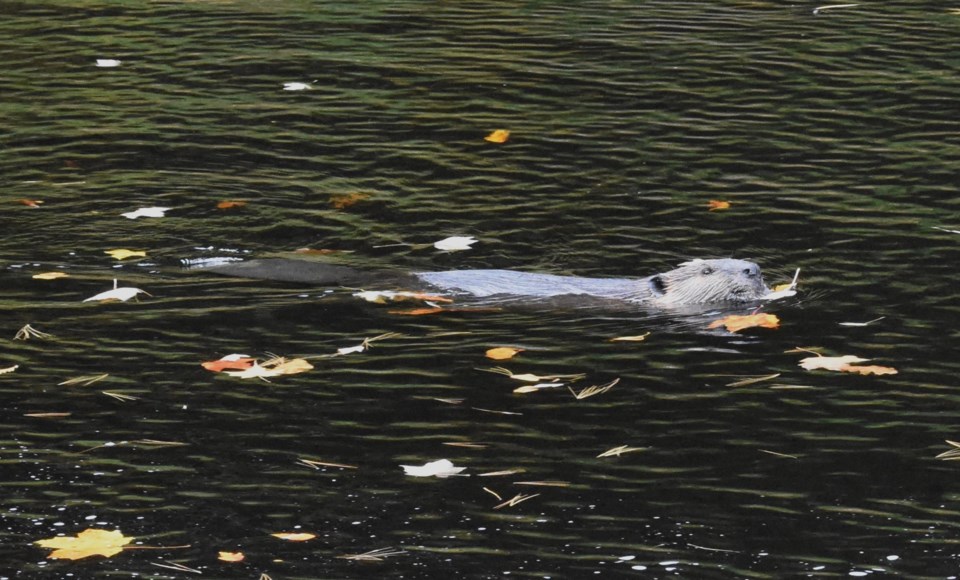Autumn is not so much a time to pause and reflect on summer, as it is a time to prepare for winter.
Food for wildlife is plentiful, the weather is acceptable for foraging, and the young of the year are either gone or at least old enough not to be a constant concern. It is a time to be busy, "busy as a beaver" as some would say.
Why pick on the beaver? Why not "busy as a red squirrel" or "busy as a white-tailed deer?" One reason is the alliteration, the words just roll off the tongue in a pleasing manner; another reason, perhaps, is that when beavers get working you will notice them: trees are removed, water is dammed... things are obviously happening!
Although beavers are rodents (that group of gnawing mammals whose front teeth are always growing) they do no hibernate like their cousins the groundhog or the jumping mouse. Nor do they seasonally migrate to areas of open water and lush food. They hunker down for the winter, hopefully snug in their lodge with enough food to sustain them until spring breakup.
The more one studies beavers, the more one realizes how complex is their relationship with water, terrain, and trees.
In terms of water management, they need a certain depth through which to swim and float trees, at least up to our knees and preferably deeper. The water protects them from some predators while allowing swift travel up and down the flooded valley without exposing themselves on shore.
The dam is a constant concern as it has to hold enough water to keep a pond flooded yet allow some leakage to ensure the dam isn't completely over-run each night. Ideally, there will be a restricted flow, with just enough resistance to keep the pond as a pond.
In areas of deep soil a dam can last many years as the base structure of large sticks is held fast into the soft soil. Looking at beaver dams built across the streams that flow on the Canadian Shield, the longevity of a dam is sometime only from one storm to the next, as the drainage force of a sudden downburst of rain can actually push the poorly anchored dam right out of the way.
When a dam breaks and the water level drops, beavers are in big trouble. Not only are they vulnerable as they waddle about the mud flats, their entrance holes to the lodge are now exposed. The high water level ensures that the normally underwater entrance tunnel is sealed from the wind, thus creating an insulated interior.
Assuming that the dam is intact, the beaver's next worry is to stockpile enough food to get through the winter months. Not only do they need enough food daily in October to sustain themselves and add a bit of a fat layer, but they must also forage for and store extra food for several months to come. Hence the "busy-ness" of a beaver.
This stockpile of branches is kept underwater, deep enough to be accessible under the winter ice. Poplar, alder and maple are the preferred tree species, as the bark is soft and fairly moist with sap. Keep in mind that the beaver does not eat the wood, only the inner bark has nutrients.
After a snack the remaining wood is like the centre of an after-dinner corn cob (in human-folk parlance) and is either discarded or used as building material.
If all goes well, by the time the temperatures drop enough to freeze up the shallow waters, the beavers will have patched the dam, strengthened the lodge walls, stored a huge pile of succulent branches, and gained a few pounds of insulating body fat.
Inside the lodge will be tired Dad beaver, pregnant Mom beaver, and one or two restless one-year old beavers. Gets kind of crowded but the combined body heat keeps the place feeling homey.
If the underwater food supply is exhausted prior to spring, or the dam leaks too much or even breaks, the situation can get pretty bad for the beavers.
There have been winters when I've discovered beaver tracks in the snow, usually accompanied by drag marks where a small tree has been nipped off and hauled back to the water.
This is a no-win situation, as the cold weather and awkward travel through the deep snow sucks up a huge amount of energy, and the little tree has almost no sap left up in the trunk so even if gnawed clean the energy replacement is less than the expenditure.
Along the tops of the steep banks of the nearby Black River can sometimes be found beaver stumps almost one metre high, evidence that the hungry beavers have had to climb up several meters of almost vertical river bank, waddle through very deep snow, find a poplar tree that was missed from last fall's gathering, gnaw it down, and slide the whole thing back into the river. The will and ability to survive is strong in a beaver.
Today I will spend my energy raking fallen leaves off the lawn and then drive to the grocery store where frozen pizzas are on sale (always good to stock up for the winter).
Admittedly, that kind of pales by comparison to the activities that will be undertaken today by the busy beavers of the real world.
